 Petzlover
Petzlover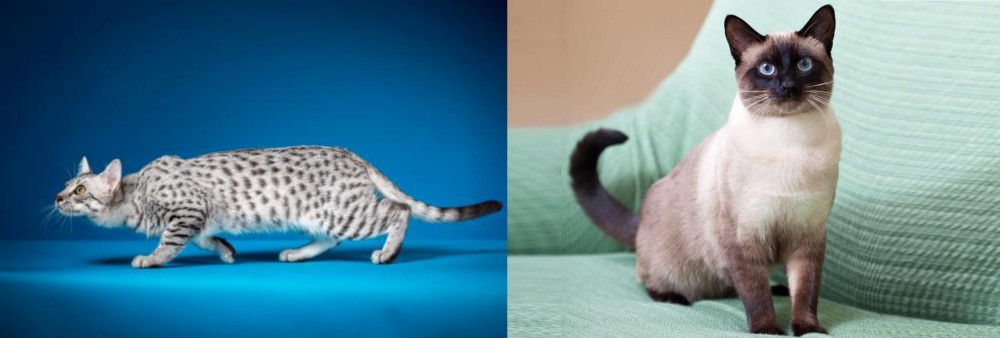 Egyptian Mau is originated from Egypt but Traditional Siamese is originated from Thailand. Both Egyptian Mau and Traditional Siamese are of same weight. Egyptian Mau may live 5 years less than Traditional Siamese. Both Egyptian Mau and Traditional Siamese has same litter size. Egyptian Mau requires Low Maintenance. But Traditional Siamese requires Moderate Maintenance
Egyptian Mau is originated from Egypt but Traditional Siamese is originated from Thailand. Both Egyptian Mau and Traditional Siamese are of same weight. Egyptian Mau may live 5 years less than Traditional Siamese. Both Egyptian Mau and Traditional Siamese has same litter size. Egyptian Mau requires Low Maintenance. But Traditional Siamese requires Moderate Maintenance
 The Egyptians have always been interested in cats, and it is believed that in 1953 a noblewoman left Egypt with a tabby cat, returning to Italy.
The Egyptians have always been interested in cats, and it is believed that in 1953 a noblewoman left Egypt with a tabby cat, returning to Italy.
Later, another cat was also brought to Italy and the pair were mated. The Egyptian Mau is a natural breed.
In 1956, a kitten of the pair was brought to the United States and the Egyptian Mau was developed. A breeding program was started in the United States. The breed Egyptian Mau was recognized in 1958 in the United States and 1992 in Europe.
 There are now three types of Siamese cats. The Traditional Siamese is said to be the original cat imported from Thailand.
There are now three types of Siamese cats. The Traditional Siamese is said to be the original cat imported from Thailand.
The Classic was the type that was common in the 50’s, 60’s and 70’s. The original Siamese cat became one of the most popular breeds in Europe and North America in the 19th century.
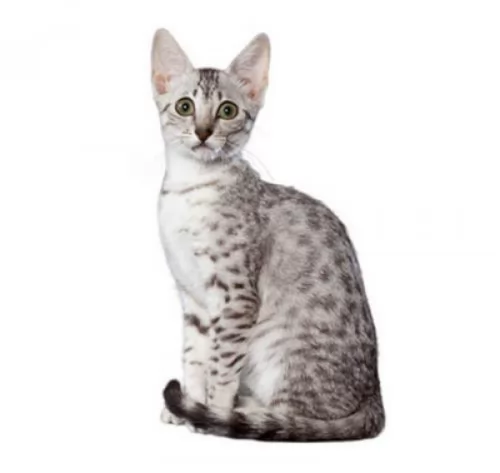 This is a medium-sized, long, athletic cat that is well muscled. It weighs between 3 to 5kg. The Mau is heavily muscled and strong. It has a triangular-shaped head with large almond-shaped eyes.
This is a medium-sized, long, athletic cat that is well muscled. It weighs between 3 to 5kg. The Mau is heavily muscled and strong. It has a triangular-shaped head with large almond-shaped eyes.
The coat of the Mau is medium in length and is glossy and soft. There are spots on the coat but the cat is particularly well known for the dark stripe that runs from its head to its tail. The coat comes in several different colors such as silver, black, tan and blue. All Maus have green eyes.
These cats are known for being loyal and friendly and they love warm weather and enjoying a spot in the sun.
They are talkative cats too and also love to sit on high perches and survey the world from these high positions. They are excellent climbers and you’ll need to supply these cats with a climbing tree. Its an intelligent breed and he will get along well with children in the home as well as be friendly towards other pets.
 The Traditional Siamese cat is medium-sized, lean, and muscular and weighs between 3 and 6kg. The coat is short and he is considered a medium shedder.
The Traditional Siamese cat is medium-sized, lean, and muscular and weighs between 3 and 6kg. The coat is short and he is considered a medium shedder.
The kittens of these cats are born white and the coloring comes in over the next days and weeks. The head of the Traditional Siamese is well proportioned to its body size.
The medium size ears are slightly rounded at the tip and the eyes are large and bright blue in color.
The coat is short, sleek, and soft and accepted colors are cream with chocolate, brown, lilac, red, tortie or blue points.
The personality of the Traditional Siamese is loud, vocal, and demanding. These cats let you know precisely what they want and it is almost like having a human companion in the house.
They love to give their human owners lots of attention as well. They’re intelligent, curious, playful, and energetic.
The Traditional Siamese cat isn’t really recognized by the Cat Fanciers Association (CFA) anymore as the breed’s temperament has changed so much.
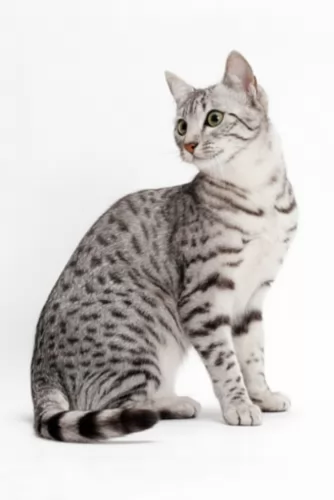 These are social cats with their own human family but the Egyptian Mau does tend to be a bit reserved around strangers.
These are social cats with their own human family but the Egyptian Mau does tend to be a bit reserved around strangers.
They make excellent pets and companions and if he is happy, you’ll hear him making little noises to express his contentment.
What also makes him so attractive as a pet is that he is a short-coated cat that is considered to be low maintenance.
Before you decide to take on any animal as a pet and before you bring the Egyptian Mau into your home, do thorough research on this rare cat breed. If you do decide to take him in, find out all you can on how to provide for him so that he receives the best care and love in your home.
 The Traditional Siamese cat is such an amazingly intelligent animal and sometimes they can become quite human.
The Traditional Siamese cat is such an amazingly intelligent animal and sometimes they can become quite human.
These are not your traditional cool, independent, sleep all day kind of felines and people liken them to having a dog as a pet. They love to play, and they are so active you could even put a leash on one and take it for a walk.
They are energetic, local, and lively. They are such affectionate cats too and they get on well with children and with other pets.
When you bring a Traditional Siamese cat into your life, it is like you are bringing in a human companion, except that the Traditional Siamese is far more amicable than many humans.
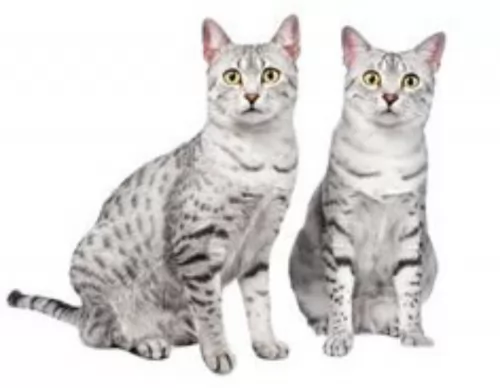 Egyptian Maus are strong, robust cats and they don't have any particular health problems.
Egyptian Maus are strong, robust cats and they don't have any particular health problems.
Obesity is a major disease with this cat and all other cats and it's worth noting, as obesity contributes to a great number of illnesses in cats. Excess weight can lead to diabetes and arthritis and well as other life-threatening diseases.
Two things that play an important role in his health are ensuring that he has access to excellent, nutritious, meaty food, as cats are carnivores.
You also want to ensure that he gets all his vaccines and de-wormings. If you notice that your cat seems to be under the weather, get him to the vet as soon as possible.
 Avoid obesity. Siamese cats are prone to obesity and these slim cats can’t afford weight gain. Extra weight can put a whole lot of pressure on the cat’s joints and they can also develop other problems such as diabetes. The label of the commercial cat food you give your Traditional Siamese will indicate how much food your cat should get a day based on your cat’s weight.
Avoid obesity. Siamese cats are prone to obesity and these slim cats can’t afford weight gain. Extra weight can put a whole lot of pressure on the cat’s joints and they can also develop other problems such as diabetes. The label of the commercial cat food you give your Traditional Siamese will indicate how much food your cat should get a day based on your cat’s weight.
Diet plays a massive role in the health of a cat, and inferior cat foods can mean you spending more money at the vet because of digestive issues.
If you are in any kind of doubt as to what to feed your cat, rather speak to your vet about what and how much to feed him. Your cat is a carnivore and it is most important to feed your cat foods high in protein.
Take your cat to the vet whenever he is sick and also just for a general check-up. You want to make sure that your Traditional Siamese is free from any health problems as well as parasites.
Also, make sure your cat is always up to date with his vaccinations as there are some cat illnesses such as feline panleukopenia, also known as distemper, that can kill your cat.
It is always a good idea as well to spay or neuter your Siamese to prevent unwanted pregnancies.
If your Traditional Siamese has any health conditions, your vet can help provide you and your pet with a treatment program.
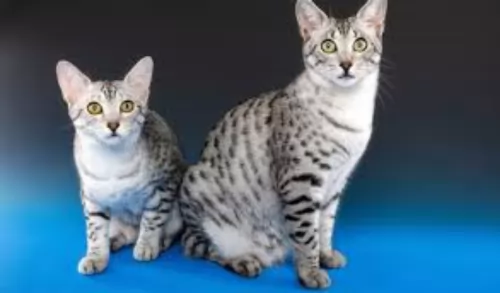 The beautiful coat of the Egyptian Mau is easy to care for and a weekly brushing will ensure it stays shiny and healthy.
The beautiful coat of the Egyptian Mau is easy to care for and a weekly brushing will ensure it stays shiny and healthy.
If he will let you, try to look inside his mouth to ensure the teeth and gums are healthy.
Remember, if there are any grooming activities for this cat that you feel you can’t cope with, professional groomers will do it for you.
Provide your Egyptian Mau with a climbing tree and scratching post as the cat loves to jump and climb.
He is an active, intelligent cat and needs to be stimulated with exciting toys, particularly when you’re not around to entertain him.
Cats such as the Egyptian Mau are clean and they want their litterbox to be kept clean. Invest in scoop and rake and rid the litter box every day of cat droppings. There also comes a time when you will have to replace all the sand or grit as well.
It will be fantastic if you can provide this cat with a water fountain and a type of pool as they love playing in water.
Make sure your Mau has constant access to fresh, cool drinking water.
 To care for your Traditional Siamese, you need to feed him a high protein diet. Always read the labels of the cat food you buy to ensure that the proteins included come from animal sources and not from plants.
To care for your Traditional Siamese, you need to feed him a high protein diet. Always read the labels of the cat food you buy to ensure that the proteins included come from animal sources and not from plants.
Brush your Traditional Siamese cat regularly. He has a short coat so once a week will be enough to keep it shiny and clean.
You can feed your cat and provide all he needs, but nothing will be more important to your cat than showing your love for him by spending lots of time with him and showering him with love.